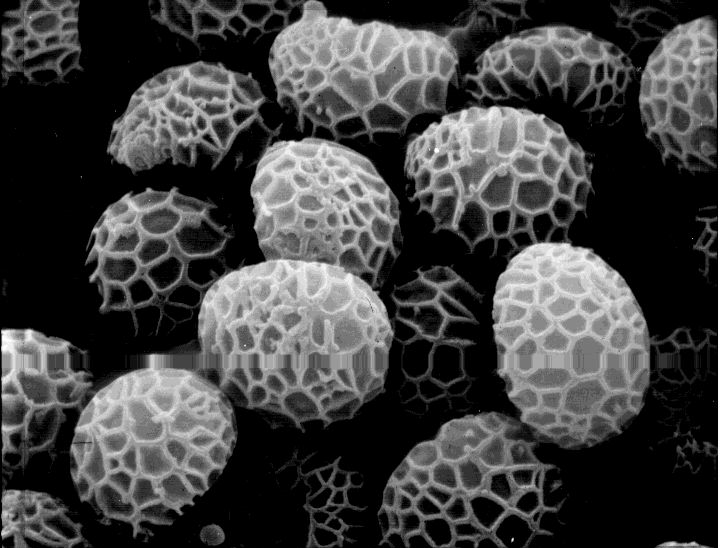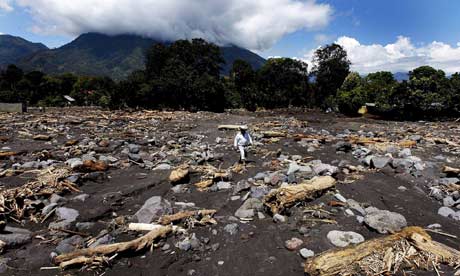1. An Introduction to Fungus (10 minutes - Review)
Mushrooms are part of a larger group of plants known as fungi. A fungus is different from an ordinary green plant because it can’t make it’s own food. Mushrooms come in many colors, shapes, and sizes. As a matter of fact, there are 38,000 different varieties. They survive by eating decaying matter. Mushrooms like to live in dark, damp places. They feed off of the decaying matter around them using mycelium. As the mushroom grows, it develops spores in the gills. The gills are located on the underside of the cap. New mushrooms grow from these spores. The spores of mushrooms are incredibly tiny and cannot be viewed without the assistance of a microscope. A collection of millions of these spores would be a minute pile of fine powder.

These mushroom spores are pictureed through the use of a scanning electron microscope (University of New Hampshire).
When the spores are ripe, they shoot out of the mushroom. They drift silently away with the currents of wind, mixing with other mushrooms. If the spores are lucky, they will land in an environment conducive to their growth and development. If they land in a dark, damp place with a food source, they will grow into new mushrooms. First, they develop a threadlike structure called a hyphae. Lots of hyphae grow together and form the mycelium. The hyphae and the mycelium grow under the surface of the ground where they can't be seen. Next, the fruiting body starts to grow above the surface. When it first appears, it looks like a little button. This button-like part of the fruiting body is called the cap. The cap is protected by a thin covering called a veil. As the mushroom grows bigger, the veil splits and falls down around the stalk (stem) of the mushroom and forms the annulus.
2. Mycellic Provisions (10 minutes - Investigate)
After introducing students to the interesting and important role of mushrooms, consider some issues related to design and the environment. Explain to students that in the upcoming lesson they will be challenged to use mushrooms as a design tool to solve a real-world problem. However, before we get to this challenge, we should consider some problems and their solutions for inspiration in our own projects.
Problem
• Soil and Water Quality - The United States is home to thousands of superfund and brownfield sites. These are designated areas that have been deemed too dangerous for habitation because the soil and surrounding area has been contaminated by toxic substances such as petroleum byproducts and other chemical runoff. (Use
https://superfund365.org/ to find out if a toxic site is near you)
• Food - Industrial farming has caused an unknown amount of damage to soil quality. If current trends persist, the development of new and innovative food production methods will be needed, especially methods that work on a more local scale.
• Deforestation - Large portions of the forested areas around the country are being devastated in order to collect timber.

This forest in Guatemala has been destroyed to harvest wood and clear the way for new development (
guardian.co.uk)
• Building Performance - Nearly 40-50% of our homes and buildings will need to be weatherized, or made more efficient to save heat and electricity over time.
Solutions
Dr. Paul Stamets, author of Mycelium Running: How Mushrooms Can Save the World has developed many of the following strategies that use the properties of mushrooms to address many environmental design problems:
• Mycoremediation - Oyster mushrooms have been proven to clean up certain types of pollution like petroleum wastes and diesel. In the 1990’s Stamets and researchers from Battelle Marine Sciences Laboratory in Sequim, Washington grew oyster-mushroom mycelia on wood chips, then sprinkled the chips onto a pile of soil drenched in diesel and other petroleum waste. The pile was covered with hundreds of pounds of oyster mushrooms within a couple of days “eating” the waste and metabolizing the substance into what Stamets believes is a harmless substrate.
• Mycofiltration - Mycofiltration is the process of using mushroom mycelium mats as biological filters. One industrial application of mycofiltration has been to prevent erosion due to water runoff. Its primary application has been on abandoned logging roads
• Mycoforestation - Mycoforestry is the use of fungi to sustain forest communities.
• Insulation - A design firm, Ecovative Design has developed a process that uses the mushroom roots, mycelium as glue for an eco-friendly insulation material. Combined with agricultural byproducts (waste products from the farm like rice husks) the mushroom glue is poured into a mold. Just like yeast and bread, over a couple of days, they digest the agricultural byproducts and form them into strong, beautiful bio-composites. This material, Greensulate can then be used to insulate buildings. (See Ecovative in the 2010 National Design Triennial)
Some other real-world applications:
• The U.S. Department of Defense’s Project BioShield is working with Dr. Paul Stamets, mycologist to use mushrooms strains like Agarikon to selectively attack cowpox and vaccinia viruses.
• Stamets is also developing a certain fungi that can infect and kill ants and termites.
• When fungal sugars are mixed with yeast and other active ingredients, they turn into “myconol”—a fuel no different from the ethanol now being blended with gasoline to power cars.
Math Application:
Use this math application to help students understand how fungus grows:
2number of generations x initial number of fungus spores = total # of fungus spore present after n generations
Example: Bacillus cereus divides every 30 minutes. You inoculate a culture with exactly 100 fungus spores. After 3 hours, how many spores are present?
In 3 hours, B. cereus will divide 6 times. Therefore, n = 6.
26 = 64 or 2x2x2x2x2x2
100 x 64 = 6,400 cells
Some other math facts/ideas:
• A mature mushroom can produce 2 billion spores in 4 days
• It takes 96 hours to produce 2 billion spores, 500 million in 24 hours
• Measuring the diameter/radius of a mushroom cap can be a great activity for geometry or measurement
3. Mycological Design Challenge (15 minutes - Generate)
Now present students with a design challenge - how can mushrooms be used to help with issues in your community? Use this as an opportunity to include geography concepts you are exploring in Social Studies.
Divide students into Myco-Design teams. Present each team with a scenario or challenge. Encourage them to use their new knowledge about mushrooms to design a solution that will be presented to you and the rest of the class:
• Brownfield/Superfund Site - There has been an oil spill in a nearby river valley. The oil is slowly spreading around the site and into the water supply. Develop a design strategy for reducing the impact of this oil spill on the environment. How can you use mushrooms to help with this challenge? Create a model and sketch out a diagram of a cleanup site and machine you would build to help.
• Deforestation - A new logging company has just left a recently logged site. The landscape has been ravaged! All that is left are stumps, mud and some grass. How can you design a strategy for helping the forest come back to life? How could mushrooms help in this process? Design a re-forestation strategy for the area and develop a plan for implementation.
• Building Performance/Insulation - You’ve just been hired by the mayor to make all of the public buildings in your town more energy efficient. But there is one catch - you need to use earth friendly materials to help insulate or fix these buildings so they save more heat and electricity. You are also located in a town that has a lot of agricultural waste. How can mushrooms be used to help make the town hall and other public buildings more energy efficient? What would your design strategy look like? Sketch out some ideas, describe the kinds of materials you would develop, use and the implementation strategy needed. See the Greensulate case study in the 2010 National Design Triennial’s catalog.
• Food - Design a farm for mushrooms that could feed 500 community members. There are many ways to grow mushrooms using controlled environments or inoculated logs or woodchips. The mushroom farm would consist of a number of environmentally controlled growing rooms/areas for logs an. A pack-house and cold store are also required along with offices and staff facilities. An area of concrete and a pasteurization room would be required for the production of compost. Each room could produce enough mushrooms for 500 people each month. However, after each harvest it will take 3-4 weeks until the next harvest. To keep a steady supply of mushrooms, you will need several rooms growing your mushrooms on a rotating basis.
4. Mushroom Design Lab (25 minutes - Edit and Develop)
Encourage students to brainstorm with their teams.
Each team must create a series of sketches, write down a proposed plan and then create either a poster diagram of their project or a 3D model using recyclable materials.
Encourage labeling and clear explanation of how mushrooms are used as an eco-design strategy to address their particular challenge.
Share each team’s design. If time permits, setup a mock community board or council in the classroom. Debate some of the proposals and as a class vote on the best project. (Share and Evaluate)